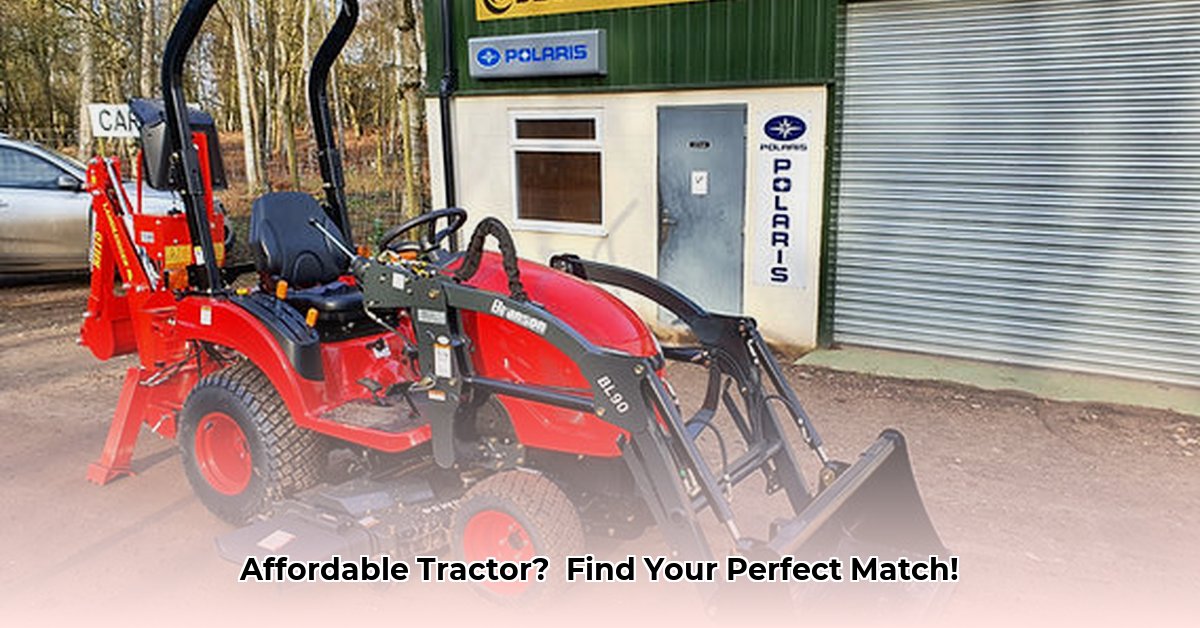
Finding the right tractor without breaking the bank can seem daunting. This guide simplifies the process, presenting top affordable tractor choices for 2025. We'll compare features, highlight pros and cons, and offer crucial considerations beyond the initial purchase price. This will help you make an informed decision that fits your budget and needs. For more in-depth pricing information, check out this helpful resource on tractor costs.
Top Affordable Tractor Choices for 2025
The market offers several excellent tractors without exorbitant price tags. Remember, prices are estimates and vary by location, dealer, and features. Always confirm prices with local dealers for accurate, up-to-date information.
| Tractor Brand & Model | Estimated Horsepower | Key Features | Pros | Cons | Approximate Price Range (USD) |
|---|---|---|---|---|---|
| Mahindra 1526 | 26 | Compact, versatile design; easy to operate and maintain. | Reliable; usually boasts good fuel efficiency; straightforward maintenance. | May have a smaller lift capacity compared to some larger models. | $15,000 - $18,000 |
| Kubota BX Series | Varies (18-26) | Compact, powerful machines; wide range of available attachments. | Excellent reputation; generally known for strong build quality; many attachments available. | Typically more expensive than other compact tractors in its class. | $18,000 - $25,000 |
| John Deere 1025R | 25 | Compact, user-friendly design; known for comfort and ease of use. | Superior operator comfort; well-designed implements (attachments) often available; generally good value. | Might offer fewer included features compared to some competitors at this price point. | $20,000 - $24,000 |
| Yanmar Compact Tractors | Varies | Fuel-efficient; known for durability and maneuverability. | Long-lasting; ideal for smaller farms or properties; very maneuverable. | Horsepower can be lower than some competitors. | $16,000 - $22,000 |
Note: Horsepower and pricing are estimates and may vary significantly based on specific configurations and your location.
Beyond the Sticker Price: Key Considerations
The initial price isn't the whole story. Consider these factors to accurately assess the total cost of ownership:
Maintenance: Regular maintenance (oil changes, filter replacements) is crucial. Factor this into your budget. Easier-to-maintain tractors save money and time in the long run.
Fuel Efficiency: Fuel costs add up. Choose a fuel-efficient model to minimize operating expenses. "Fuel efficiency is a major factor for long-term cost savings," notes John Miller, Agricultural Engineer at Purdue University.
Resale Value: Some brands retain value better than others. Research resale value to assess its impact on your overall investment. This is especially vital if you plan to sell the tractor eventually.
Dealer Support: A reliable local dealer simplifies maintenance and parts replacement. Consider proximity and reputation when selecting a brand. "A strong dealer network is invaluable," says Sarah Chen, Agricultural Economist at the University of California, Davis.
Making Your Decision: Finding the Right Tractor
Choosing the right tractor is a significant investment. Thoroughly compare your needs against each model's features and long-term costs. Don't rush the process. Research thoroughly, and seek advice from experienced tractor owners. Careful planning allows you to find an affordable tractor that well suits your needs and budget.
Comparing Tractor Specifications: A Practical Guide
Navigating the diverse world of compact tractors requires a systematic approach for comparison. This section provides a structured guide to help you effectively compare tractor specifications from various online sources.
Key Takeaways:
- Comparing specifications across multiple sources is vital for making informed decisions.
- Horsepower, lift capacity, and implement compatibility are critical for productivity.
- Considering fuel efficiency translates to long-term budget savings.
Decoding the Specifications: What to Look For
Before comparing, define your tractor's purpose. Mowing? Tilling? Hauling? This dictates horsepower, lift capacity, and PTO (power take-off) needs.
Key specifications to compare across different sources include:
- Horsepower (HP): Engine power – higher HP handles heavier tasks.
- Lift Capacity: Weight the tractor can lift with its three-point hitch; critical for implements.
- Three-Point Hitch: System connecting implements to the tractor; check for compatibility.
- PTO (Power Take-off): Shaft powering equipment like tillers; note horsepower and speed.
- Transmission: Type (manual, hydrostatic) affects ease of use and suitability for specific tasks.
- Ground Clearance: Important for uneven terrain; higher clearance better for uneven fields.
- Fuel Efficiency: A major factor in long-term running costs.
A Step-by-Step Comparison Guide
- Identify Reputable Sources: Begin with established agricultural equipment and review websites.
- Select Tractor Models: Choose several models meeting your horsepower and feature requirements.
- Gather Specifications: Record each tractor's specifications from each source. Note any discrepancies that arise.
- Analyze and Verify: Create a spreadsheet to compare specifications. Investigate any inconsistencies.
- Final Verification: Consult reviews on independent forums for real-world experiences before making a final decision.